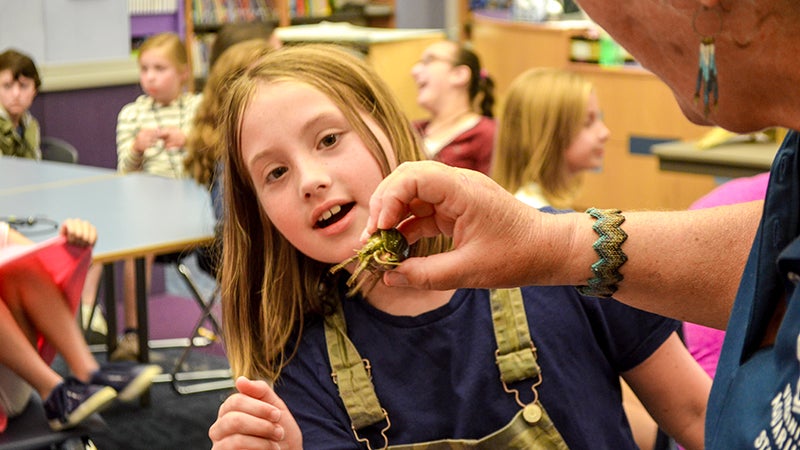Turtles, whelks, spider crabs — oh my!
Published 10:00 pm Wednesday, July 17, 2019

- Abigail Powell, rising fourth grader at Oakland Elementary School, observes on the sea critters held by Jacqui Stanford, outreach educator at Virginia Aquarium and Marine Science Center, in the Pioneer Elementary School library on Friday.
Students were wowed by close encounters of the marine kind on Friday at Pioneer Elementary School.
Jacqui Stanford, outreach educator at Virginia Aquarium and Marine Science Center, conducted a presentation for young students in the Tidewater Regional Governor’s School’s summer program.
Stanford’s audience learned about some of the animals that reside in the Chesapeake Bay, as well as the adaptations they have for survival. She did this with both animal remains and living examples that captured the attention of her students.
“They are just always interested in the animals,” Stanford said about the students. “If you have a living animal, then you have them hooked.”
The Governor’s School has held this hands-on learning program since 1993. The school selects 60 gifted students — rising fourth- through seventh-graders — out of more than 200 applicants from Suffolk, Isle of Wight, Franklin and Southampton.
This year, 30 of those students are from Suffolk Public Schools, according to Tidewater Regional Governor’s School Executive Director Leslie Moring.
The students were divided into groups of 30 on Friday, and both groups had their own morning session with Stanford in the Pioneer Elementary School library.
Stanford showed her students a dolphin’s skull to demonstrate different features. Dolphin’s eyes, for example, are lateral and on either side of the skull, which allow dolphins to see in front of them, beside them and even behind them.
They got to take a close look at shark teeth, including those of a sandbar shark and a sand tiger shark, and the carapace of a turtle.
But Tyson, a live diamondback terrapin, was the turtle that made the biggest impression on the students Friday morning. Stanford held Tyson for each student to gently touch, if they wanted to, and the children marveled at the turtle’s colorful appearance.
They were introduced to the knobbed whelk, a large, carnivorous sea snail that lives in tidal estuaries along the Atlantic coast. These snails feed on clams, oysters, mussels and other bivalves.
There were also hermit crabs that quickly poked their heads out of their shells and surprised the students — but not as surprising as when the decorator crab got the spotlight.
Decorator crabs earn their name by decorating themselves with smaller animals, seaweed and other plants from their habitats, which are fastened to the back of their shells with Velcro-like bristles called setae.
They’re also known as spider crabs for their long legs. Stanford held this spider-like crab in her hand, and the crab spread its legs wide in front of the students, trying to make itself look as imposing as possible in the situation.
Its appearance made quite an impression on the young students.
“It had long legs and stuff,” said Jeremiah Martin, a rising fifth-grader at S.P. Morton Elementary School in Franklin, said about the decorator crab. “That was my favorite (animal).”
Nansemond Parkway Elementary School rising fourth-grader Neelima Kosuri’s favorite part was touching the “sharp and spiky” shark teeth, but she also enjoyed the creepy spider crab.
“It’s scary, but also cool,” Neelima said.
The animal demonstration tied into the students’ other activities for the week, which included selecting a Virginia marine organism to research and discuss. The students will learn their respective organism’s various adaptations, its place in the food web and how it’s impacted by humans, like how sea turtles are harmed by plastic bags, Moring said.
Moring said the students were really interested in Stanford’s Friday morning lessons, especially the ones that were alive and stared right back at them.
“They were asking a lot of questions,” Moring said about her students, and also answered Stanford’s questions in turn. “I think it went really well.”






